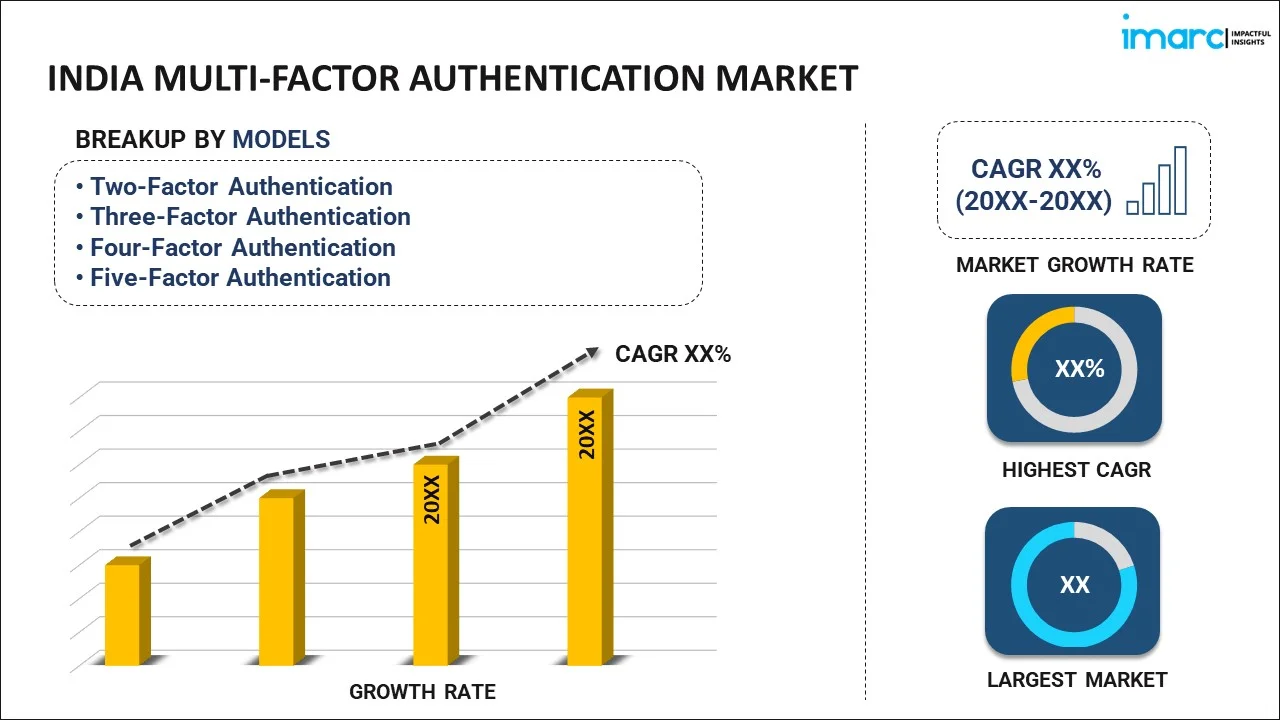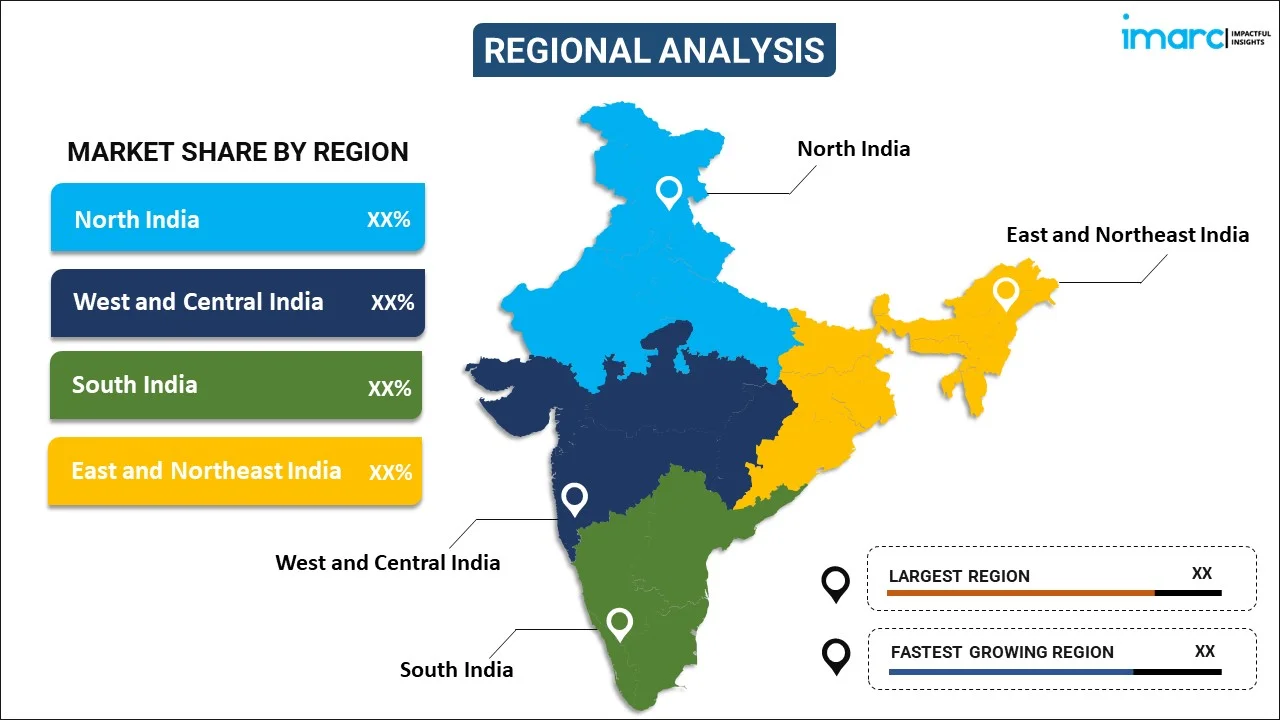
India Multi-Factor Authentication Market Report by Model (Two-Factor Authentication, Three-Factor Authentication, Four-Factor Authentication, Five-Factor Authentication), Deployment Type (On-Premises, On-Cloud), Application (Smart Card Authentication, Phone-Based Authentication, Hardware OTP Token Authentication), Vertical (Banking and Finance, Government, Travel and Immigration, Military and Defence, IT and Telecom, Healthcare, Retail and Ecommerce, and Others), and Region 2024-2032
Market Overview:
India multi-factor authentication market size is projected to exhibit a growth rate (CAGR) of XX% during 2024-2032. The rising focus of organizations on data protection, regulatory compliance, and the prevention of identity theft and fraud is primarily driving the market growth across the country.
|
Report Attribute
|
Key Statistics
|
|---|---|
|
Base Year
|
2023 |
|
Forecast Years
|
2024-2032
|
|
Historical Years
|
2018-2023
|
| Market Growth Rate (2024-2032) | XX% |
Multi-factor authentication (MFA) stands as an advanced security protocol meticulously crafted to bolster the safeguarding of digital accounts and systems. Its mechanism involves necessitating users to furnish several forms of identification, encompassing elements like passwords, fingerprints, or facial recognition, as prerequisites for access. This intricate process significantly elevates security measures, introducing heightened complexity for unauthorized individuals attempting to breach accounts or systems. The primary objective of multi-factor authentication is to fortify security by presenting multiple layers of verification, thereby contributing to a robust defense against potential threats and fraudulent activities. Given its effectiveness in mitigating security risks, there is a growing demand for MFA solutions throughout the country.
India Multi-Factor Authentication Market Trends:
The multi-factor authentication market in India has emerged as a critical component of the country's cybersecurity landscape, reflecting the increasing need for robust digital security measures. Moreover, as the digital landscape expands and cyber threats become more sophisticated, the demand for MFA solutions in India is on the rise. Besides this, organizations across various sectors, including finance, healthcare, and e-commerce, are recognizing the importance of implementing advanced authentication methods to safeguard sensitive information and prevent unauthorized access. Additionally, one of the key strengths of multi-factor authentication is its ability to reduce the risk of unauthorized access significantly. By requiring multiple forms of identification, MFA makes it more challenging for cybercriminals to compromise accounts or systems, providing a higher level of security compared to traditional single-factor authentication methods. Apart from this, the India multi-factor authentication market is witnessing substantial growth as businesses and government entities seek comprehensive solutions to address evolving cybersecurity challenges. As the digital transformation continues to accelerate in India, the multi-factor authentication plays a pivotal role in ensuring the integrity and security of digital identities, contributing to a safer and more resilient digital ecosystem. This, in turn, is anticipated to fuel the market growth over the forecasted period.
India Multi-Factor Authentication Market Segmentation:
IMARC Group provides an analysis of the key trends in each segment of the market, along with forecasts at the country level for 2024-2032. Our report has categorized the market based on model, deployment type, application, and vertical.
Model Insights:

- Two-Factor Authentication
- Three-Factor Authentication
- Four-Factor Authentication
- Five-Factor Authentication
The report has provided a detailed breakup and analysis of the market based on the model. This includes two-factor authentication, three-factor authentication, four-factor authentication, and five-factor authentication.
Deployment Type Insights:
- On-premises
- On-Cloud
A detailed breakup and analysis of the market based on the deployment type have also been provided in the report. This includes on-premises and on-cloud.
Application Insights:
- Smart Card Authentication
- Phone-Based Authentication
- Hardware OTP Token Authentication
The report has provided a detailed breakup and analysis of the market based on the application. This includes smart card authentication, phone-based authentication, and hardware OTP token authentication.
Vertical Insights:
- Banking and Finance
- Government
- Travel and Immigration
- Military and Defence
- IT and Telecom
- Healthcare
- Retail and E-commerce
- Others
A detailed breakup and analysis of the market based on the vertical have also been provided in the report. This includes banking and finance, government, travel and immigration, military and defence, IT and telecom, healthcare, retail and e-commerce, and others.
Regional Insights:

- North India
- West and Central India
- South India
- East and Northeast India
The report has also provided a comprehensive analysis of all the major regional markets, which include North India, West and Central India, South India, and East and Northeast India.
Competitive Landscape:
The market research report has also provided a comprehensive analysis of the competitive landscape. Competitive analysis such as market structure, key player positioning, top winning strategies, competitive dashboard, and company evaluation quadrant has been covered in the report. Also, detailed profiles of all major companies have been provided.
India Multi-Factor Authentication Market Report Coverage:
| Report Features | Details |
|---|---|
| Base Year of the Analysis | 2023 |
| Historical Period | 2018-2023 |
| Forecast Period | 2024-2032 |
| Units | US$ Million |
| Scope of the Report | Exploration of Historical Trends and Market Outlook, Industry Catalysts and Challenges, Segment-Wise Historical and Future Market Assessment:
|
| Models Covered | Two-Factor Authentication, Three-Factor Authentication, Four-Factor Authentication, Five-Factor Authentication |
| Deployment Types Covered | On-Premises, On-Cloud |
| Applications Covered | Smart Card Authentication, Phone-Based Authentication, Hardware OTP Token Authentication |
| Verticals Covered | Banking and Finance, Government, Travel and Immigration, Military and Defence, IT and Telecom, Healthcare, Retail and Ecommerce, Others |
| Regions Covered | North India, West and Central India, South India, East and Northeast India |
| Customization Scope | 10% Free Customization |
| Report Price and Purchase Option | Single User License: US$ 2699 Five User License: US$ 3699 Corporate License: US$ 4699 |
| Post-Sale Analyst Support | 10-12 Weeks |
| Delivery Format | PDF and Excel through Email (We can also provide the editable version of the report in PPT/Word format on special request) |
Key Questions Answered in This Report:
- How has the India multi-factor authentication market performed so far and how will it perform in the coming years?
- What has been the impact of COVID-19 on the India multi-factor authentication market?
- What is the breakup of the India multi-factor authentication market on the basis of model?
- What is the breakup of the India multi-factor authentication market on the basis of deployment type?
- What is the breakup of the India multi-factor authentication market on the basis of application?
- What is the breakup of the India multi-factor authentication market on the basis of vertical?
- What are the various stages in the value chain of the India multi-factor authentication market?
- What are the key driving factors and challenges in the India multi-factor authentication?
- What is the structure of the India multi-factor authentication market and who are the key players?
- What is the degree of competition in the India multi-factor authentication market?
Key Benefits for Stakeholders:
- IMARC’s industry report offers a comprehensive quantitative analysis of various market segments, historical and current market trends, market forecasts, and dynamics of the India multi-factor authentication market from 2018-2032.
- The research report provides the latest information on the market drivers, challenges, and opportunities in the India multi-factor authentication market.
- Porter's five forces analysis assist stakeholders in assessing the impact of new entrants, competitive rivalry, supplier power, buyer power, and the threat of substitution. It helps stakeholders to analyze the level of competition within the India multi-factor authentication industry and its attractiveness.
- Competitive landscape allows stakeholders to understand their competitive environment and provides an insight into the current positions of key players in the market.
Need more help?
- Speak to our experienced analysts for insights on the current market scenarios.
- Include additional segments and countries to customize the report as per your requirement.
- Gain an unparalleled competitive advantage in your domain by understanding how to utilize the report and positively impacting your operations and revenue.
- For further assistance, please connect with our analysts.
 Inquire Before Buying
Inquire Before Buying
 Speak to an Analyst
Speak to an Analyst
 Request Brochure
Request Brochure
 Request Customization
Request Customization




.webp)




.webp)












